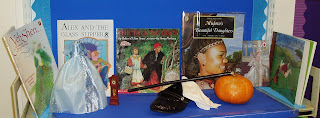Sunday, April 29, 2007
Geography - webquests
It includes a webquest about countries, in which pupils take on the role of a tour guide and research necessary background information. It is designed for KS3, but could be adapted for upper KS2. It includes links for finding out about Brazil, Greece and Australia.
There is also one about weather, comparing forecasts with recording the actual weather.
Saturday, April 28, 2007
Languages and Espresso video clips
I'm also going to use lots of pictures and videos to give children an idea of what it is like in the countries we study. Espresso's geography passport section covers Scotland, Sudan, India, Australia, Madagascar and Chile. The geography news section includes videos about Icons of England, Find out about Germany, Changing China, Changing India, Arctic Explorers, The Queen in Australia, Drought in Kenya, Australian drought and Floods in Indonesia.
Tourist Information and Travel Agent role play
I've also spent this morning going round travel agents to collect brochures. I'm trying to find space in my classroom to set up a travel agent role play area, inspired by ideas from Trinity Educational (including a free download of ideas, photos and a booking form template for children to use) and Role Play Online.
I'm going to try to use this in maths, for example:
- data handling - weather graphs and statistics
- time - timetables, flight departure times, itineraries
- calculations - travel, hotel and attraction prices
- measures - weight and size allowances for luggage
I'll also use it in literacy, for example designing adverts, brochures and tourist information. And obviously it will link in with geography!
Friday, April 27, 2007
Geography - our trip round the world
I've started a class blog to record our comments and links to useful websites. I've written the first posts, but future posts will hopefully be written by the children (and approved by me before being published!).
I've also been using images of the current country as the background for my desktop on the IWB. The easiest way I've found is to search Google images and select medium or large pictures. When you find the picture you want, right-click and choose 'Set as Background'. You could also use your own digital photos. This has started a few interesting discussions and enabled the class to see photos of a wide range of locations.
Maths interactive display - time

- teaching clocks
- sand timers
- stopwatches
- tockers
- books about the invention of the clock
- sheets with blank clock faces
- clock face stamps and templates
It was great to see children using the resources independently during maths lessons, for example deciding that one of the clocks would help them to find the difference between two times. Groups of children also explored the timers and tockers during morning work when they come into the classroom in the morning. I also used 'snap' cards for children to match up analogue and digital times. This was particularly useful with my lower attainers, to practise basic skills.
I am going to try a similar approach with fractions resources next week. Hopefully the resources will support children during maths lessons, stimulate discussion between children and promote the exploration of ideas.
Sunday, April 22, 2007
Make believe...?
In the autumn term, I tried using email. I created an account under the name of Professor Bubble. We were studying gases in science, and I sent the class an email from him saying that he didn't think gases existed. The idea was that we would do the experiments I'd planned and then email him, proving him wrong. But my class saw through it immediately, insisting that the email was from me.
This doesn't put me off though, despite knowing that my class think I'm slightly mad. They're quite willing to humour me, but they make it fairly obvious that's what they're doing and that they don't belive me for a moment!
Saturday, April 21, 2007
Success Criteria
- Classworks marking ladders
- Bristol LEA - literacy success criteria
- Juliateacher's marking stickers
- AfL resources
- extracts from Shirley Clarke book
- Cumbria grid - using success criteria in maths
VCOP display
The files for the VCOP headings and connective cards are on TES resources - follow the links to the right. In the vocabulary section I included four posters defining types of words and giving examples. The punctuation characters are from Trinity Education. The pyramids that I have used for punctuation and sentence openers are available from many websites, including Primary Ideas.
Thursday, April 05, 2007
Cinderella project

We unpicked what was similar about all the stories and what were the essential parts of a Cinderella story. They used that knowledge to plan their own version. Some of them were very inventive - nerds who had lost their maths book, a motorbike race and singing competitions. They then wrote the stories in their books. Over the last three days of term, they used the laptops to type up the stories and painted illustrations for their books. In small groups, I helped the children to stitch the pages of their book together. On the final day, they stuck their text and illustrations into the book and shared their books with the Year 3 classes.
Almost all the children created a book that they were very proud of. Apart from one afternoon when they got a bit restless, they were motivated and focused on the task and the classroom had a very calm, productive atmosphere.
I think the success of the project came from the quality texts that were used, the visual activities that helped them to understand the stories and the time given to produce an extended piece of work with a real audience.
